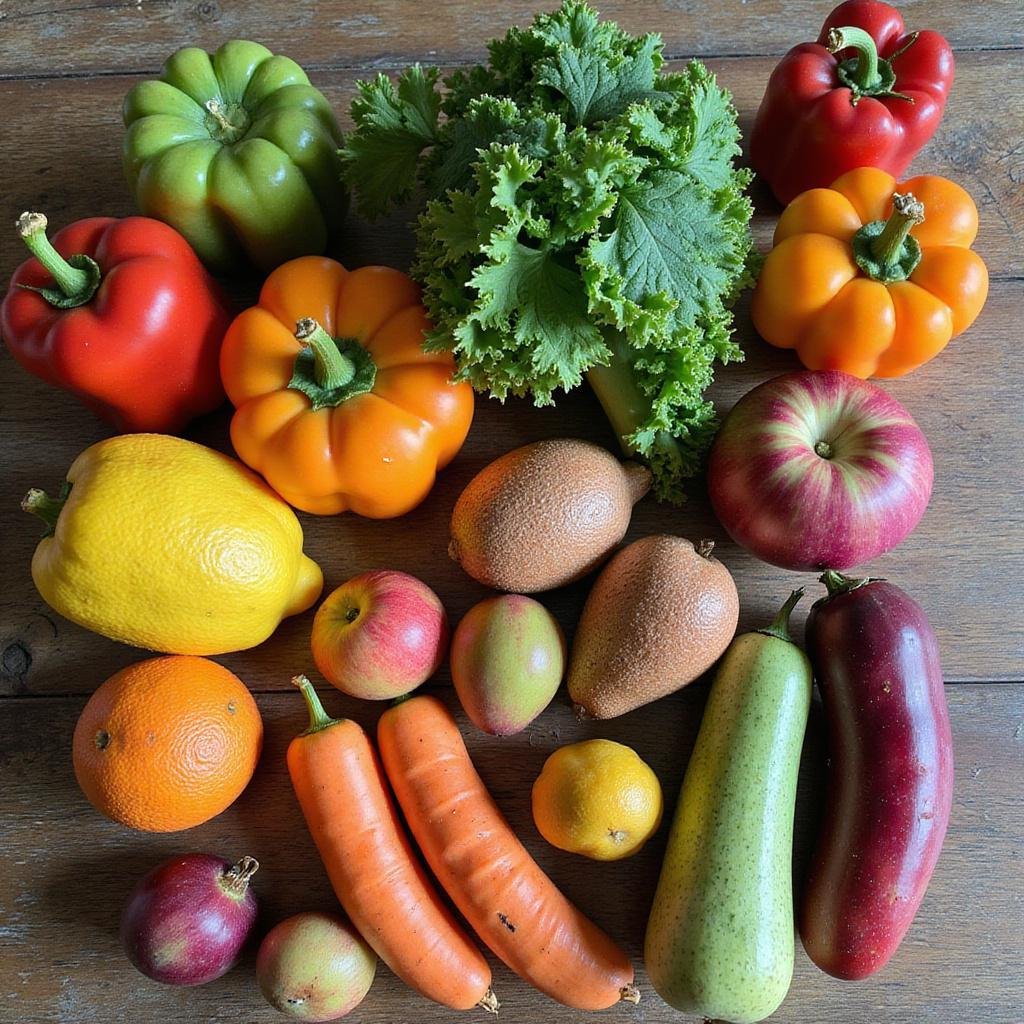1. Introduction
Welcome to your ultimate Seasonal Produce Guide with Recipes By Month. Understanding the nuances of seasonal fruits and vegetables is essential for elevating your culinary skills, ensuring peak freshness, and maximizing flavor profiles. This comprehensive guide will help you navigate through the most abundant produce available during each month, paired with delicious, easy-to-make recipes. Whether you’re a home chef, food enthusiast, or professional cook, leveraging seasonal ingredients not only enhances taste but also supports sustainable eating practices. To get started with essential kitchen tools, consider investing in the Fullstar Vegetable Chopper and Spiralizer, which simplifies prepping fresh produce for your weekly meals.
2. Why Use Seasonal Produce?
Incorporating seasonal produce into your diet offers a multitude of benefits. First, ingredients harvested at their peak ripeness provide superior flavor and nutritional value, making your meals healthier and more satisfying. Moreover, buying local and seasonal helps reduce your carbon footprint by cutting down on transportation emissions. Seasonal fruits and vegetables tend to cost less because they are more plentiful during their harvest window, and they often taste better due to freshness. Additionally, experimenting with seasonal ingredients keeps your menus dynamic, inspiring creativity with each month’s unique offerings. For example, pairing spring ingredients like asparagus and strawberries can energize your cooking routine.

3. Monthly Overview of Seasonal Produce
Staying ahead with insight into what produce is available each month allows you to plan your market visits and kitchen experiments efficiently. Here’s an expanded look at what’s in season, along with recipe inspirations that leverage these ingredients for healthy, flavorful dishes.
January
January is the perfect time to embrace hearty root vegetables like carrots, parsnips, and turnips. Incorporate these into warm soups and stews, which are comforting and nutritious. Leafy greens such as kale and Swiss chard are also in season, ideal for sautéing or adding raw to salads. For an all-in-one kitchen essential, use the CAROTE Nonstick Pots and Pans Set for quick, easy cooking of winter vegetables. To streamline prep, the Fullstar Vegetable Chopper and Spiralizer is invaluable for swiftly preparing ingredients for steaming or roasting.
February
In February, root vegetables continue to shine, complemented by the arrival of citrus fruits like oranges and grapefruits. These bright, tangy fruits are perfect for juicing or adding zest to salads. Consider making citrus-glazed chicken or a fresh orange and fennel salad, especially useful when paired with a versatile kitchen gadget like the Ninja Air Fryer Pro for quick, crispy dishes. Additionally, winter squash varieties such as acorn and butternut are ideal for baking, roasting, or creating hearty purees.
March
March marks the beginning of spring, bringing fresh spring onions, peas, and spinach to the forefront. These ingredients can be transformed into vibrant salads, light pasta dishes, or even vegetable pestos. To toast or sauté these greens effortlessly, the KitchenAid Classic Stand Mixer proves useful for preparing homemade pestos or doughs. The season invites a variety of quick cooking methods that preserve the fresh flavors of early spring produce.
April
As spring fully unfolds, strawberries become a staple, bringing sweetness to any dish. Combine strawberries with fresh greens in salads or blend into smoothies using the powerful Ninja Mega Kitchen System Blender. Asparagus and radishes also make their debut, excellent for quick sautés or pickling. Elevate your kitchen arsenal by visiting your local farmers’ market for the best seasonal picks or checking out popular tools like the Ninja Air Fryer Pro for crisping vegetables with less oil, keeping your dishes healthy and flavorful.
May
May is a celebration of fresh cherries, blueberries, and tender greens. These are perfect for creating vibrant salads, smoothies, or baked goods. Incorporate the KitchenAid Stand Mixer to make doughs or whipped toppings that elevate your recipes. For those who love to prepare ahead, the JoyJolt Glass Storage Containers make storing fresh produce or leftovers a breeze, ensuring your seasonal ingredients stay fresh longer.
June
Jump into summer with abundant berries, zucchinis, and peas. These can be used for grilling, making jams, or baking. Grilled zucchini slices or berry crumbles are summer staples. Using an All-in-One Vegetable Spiralizer can turn zucchinis into pasta for healthier meals. Freshly picked summer produce tastes best when used shortly after harvest, so explore quick prep techniques with tools like the Ninja Air Fryer for crisp vegetables or fruits.
July
High summer calls for tomatoes, bell peppers, and eggplants. These ingredients shine in everything from caprese salads to grilled vegetable platters. The Cuisinart Nonstick Cookware Set helps you cook these ingredients perfectly. For quick and flavorful meals, the Ninja Air Fryer Pro is excellent for roasting peppers or crisping up eggplant slices.
August
August is all about peaches, plums, and sweet corn. These can be used in salads, salsas, or baked desserts. For easy prep, consider the Vegetable Chopper and Spiralizer for creating corn salads or fruit-based treats. Freshly harvested produce is at its peak, so adapt recipes like fruit salsas or grilled corn for maximum flavor.
September
As fall approaches, apples, pears, and squash fill markets. Use these for roasting, baking, or soups. A warm apple and pumpkin soup can be made easily with the Toshiba Microwave Oven to quickly heat ingredients or reheat leftovers. These seasonal flavors create comforting, hearty dishes perfect for the season.
October
Pumpkins, Brussels sprouts, and root vegetables take center stage. Make everything from pumpkin pie with your own homemade puree to roasted Brussels sprouts with balsamic glaze. The Cuisinart Nonstick Pots and Pans make sautéing and roasting effortless. Fresh, seasonal harvests bring vibrant color and flavor to your table.
November
November’s hearty vegetables like sweet potatoes, parsnips, and cranberries are staples for Thanksgiving and cozy meals. Roast sweet potatoes with cinnamon or make cranberry sauce from scratch. For meal preparation efficiency, the KitchenAid Stand Mixer is perfect for creating variety in your baking or side dishes.
December
December rounds out the year with winter citrus, Brussels sprouts, and hearty greens. Celebrate with citrus-infused desserts or roasts. The Toshiba Microwave helps quickly prepare holiday dishes, while the Fullstar Vegetable Chopper simplifies prepping winter vegetables for sides or salads.
4. Recipes by Month: Incorporating Seasonal Produce
Being mindful of seasonal produce ensures superior flavor and freshness, making your dishes more vibrant and nutritious. Here are some inspired recipes tailored for each month’s bounty:
- January: Warm roasted root vegetable medley with herbs, utilizing the Fullstar Chopper for quick prep.
- February: Citrus glazed chicken paired with a fresh orange salad, perfect with a Ninja Air Fryer for fast crisping.
- March: Spinach and feta frittata, with the Stand Mixer for mixing eggs and fillings seamlessly.
- April: Strawberry spinach salad, enhanced with fresh herbs and a tangy vinaigrette.
- May: Grilled vegetable skewers using early-season zucchinis and peppers, cooked perfectly with the Ninja Air Fryer.
- June: Berry and banana smoothie for a refreshing breakfast, blended with the Mega Kitchen System.
- July: Classic Caprese salad with heirloom tomatoes and basil, drizzled with olive oil.
- August: Corn and avocado salsa, perfect for summer gatherings.
- September: Hearty apple and pumpkin soup, blended smoothly using the Ninja Air Fryer.
- October: Roasted squash and Brussels sprouts, a healthy side dish for any autumn meal.
- November: Sweet potato casserole with marshmallows, baked to perfection in your *Cuisinart* pan.
- December: Cranberry orange muffins, ideal for holiday mornings and festive gatherings.
5. Tips for Buying and Storing Seasonal Produce
Make the most of seasonal shopping with these tips:
- Support local farmers by visiting farmers’ markets—your best source for fresh, seasonal produce. Need the right tools? Check out the CAROTE Cookware Set to help cook seasonal vegetables efficiently.
- Store root vegetables in a cool, dark, and dry environment to prolong freshness.
- Keep leafy greens in breathable containers, such as those found in the Glass Storage Set.
- Prep ingredients ahead of time—washing, peeling, or chopping—using versatile tools like the Fullstar Chopper.
- Learn seasonal harvest periods for your region to optimize your shopping strategy and ingredient freshness.
6. Frequently Asked Questions
What are the advantages of eating seasonal produce?
Eating seasonal fruits and vegetables ensures you receive ingredients at their highest nutritional value, packed with flavor. It also supports local economies and reduces environmental impact by minimizing transportation and storage needs. Plus, seasonal produce often costs less and encourages variety in your diet by introducing you to different flavors throughout the year.
How can I determine if a fruit or vegetable is in season in my area?
Check with local farmers’ markets, regional seasonality charts, or harvest calendars tailored to your climate. Many grocery stores also label produce with harvest or peak season info. Adjust your shopping based on local agricultural practices and regional climate conditions to enjoy the freshest, tastiest ingredients.
What are the best storage practices for seasonal produce?
Proper storage varies: root vegetables like carrots and radishes are best kept in a cool, dark, ventilated space; leafy greens should be stored in paper bags inside the fridge; fruits like berries and peaches need refrigeration once ripe. Use the Glass Storage Containers for meal prepping and extending the freshness of your seasonal bounty.
7. Conclusion
Embracing the Seasonal Produce Guide with Recipes By Month is a sustainable, flavorful approach to healthy eating. By aligning your meal planning with the natural harvest cycles, you gain access to the freshest, most delicious ingredients year-round. Incorporate these seasonal gems into your recipes to enhance taste, nutrition, and culinary diversity. Remember, the right tools like the Fullstar Vegetable Chopper and quality cookware make cooking with seasonal ingredients easier and more enjoyable. Start exploring each month’s unique offerings and elevate your cooking today!


2 thoughts on “Seasonal Produce Guide with Recipes By Month”